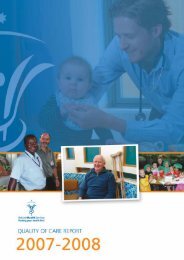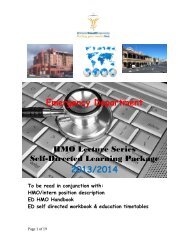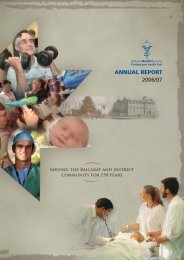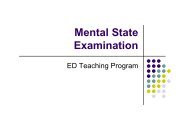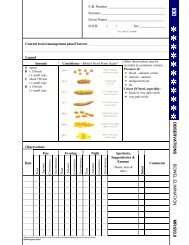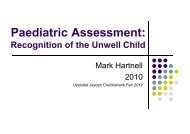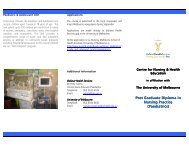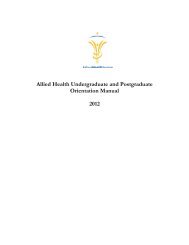2012 Annual Report - Ballarat Health Services
2012 Annual Report - Ballarat Health Services
2012 Annual Report - Ballarat Health Services
You also want an ePaper? Increase the reach of your titles
YUMPU automatically turns print PDFs into web optimized ePapers that Google loves.
Note 1: Summary of Signifi cant Accounting Policies (continued)<br />
Revaluations of Non-Current Physical Assets<br />
Non-current physical assets are measured at fair value and are revalued in<br />
accordance with FRD 103D Non-current physical assets. This revaluation process<br />
normally occurs at least every fi ve years, based upon the asset’s Government<br />
Purpose Classifi cation, but may occur more frequently if fair value assessments<br />
indicate material changes in values. Independent valuers are used to conduct<br />
these scheduled revaluations and any interim revaluations are determined<br />
in accordance with the requirements of the FRDs. Revaluation increments or<br />
decrements arise from differences between an asset’s carrying value and fair<br />
value.<br />
Revaluation increments are credited directly to the asset revaluation reserve,<br />
except that, to the extent that an increment reverses a revaluation decrement<br />
in respect of that same class of asset previously recognised at an expense in net<br />
result, the increment is recognised as revenue in the net result.<br />
Revaluation decrements are recognised immediately as expenses in the net result,<br />
except that, to the extent that a credit balance exists in the asset revaluation<br />
reserve in respect of the same class of assets, they are debited directly to the<br />
asset revaluation reserve.<br />
Revaluation increases and revaluation decreases relating to individual assets<br />
within a class are offset against one another within that class but are not offset<br />
in respect of assets in different classes.<br />
Revaluation reserves are normally not transferred to accumulated funds on<br />
derecognition of the relevant asset.<br />
A review based on FRD103D and Valuer-General Victoria Indices was conducted<br />
and that indicated a change of greater than 10% to overall valuations. In<br />
accordance with FRD103D, <strong>Ballarat</strong> <strong>Health</strong> <strong>Services</strong> non-current physical assets<br />
were assessed to determine whether revaluation of the non-current physical<br />
assets was required.<br />
Intangible Assets<br />
Intangible assets represent identifi able non-monetary assets without physical<br />
substance such as patents, trademarks, and computer software and development<br />
costs.<br />
Intangible assets are initially recognised at cost. Subsequently, intangible assets<br />
with fi nite useful lives are carried at cost less accumulated amortisation and<br />
accumulated impairment losses. Costs incurred subsequent to initial acquisition<br />
are capitalised when it is expected that additional future economic benefi ts will<br />
fl ow to the <strong>Health</strong> Service.<br />
Other Non-Financial Assets<br />
Prepayments<br />
Other non-fi nancial assets include prepayments which represent payments in<br />
advance of receipt of goods or services or that part of expenditure made in one<br />
accounting period covering a term extending beyond that period.<br />
Disposal of Non-Financial Assets<br />
Any gain or loss on the sale of non-fi nancial assets is recognised at the date that<br />
control of the asset is passed to the buyer and is determined after deducting<br />
from the proceeds the carrying value of the asset at the time.<br />
(l) Liabilities<br />
Payables<br />
Contractual payables which consist predominantly of accounts payable<br />
representing liabilities for goods and services provided to <strong>Ballarat</strong> <strong>Health</strong> <strong>Services</strong><br />
prior to the end of the fi nancial year that are unpaid, and arise when the health<br />
service becomes obliged to make future payments in respect of the purchase of<br />
those goods and services.<br />
Contractual payables are initially recognised at fair value, and then subsequently<br />
carried at amortised cost. Statutory payables are recognised and measured<br />
similarly to contractual payables, but are not classifi ed as fi nancial instruments<br />
and not included in the category of fi nancial liabilities at amortised cost, because<br />
they do not arise from a contract.<br />
The normal credit terms are usually 30 Days from the end of the month in which<br />
the invoice was raised.<br />
Notes to and forming part of the fi nancial statements for the year ended 30 June <strong>2012</strong>.<br />
Provisions<br />
Provisions are recognised when <strong>Ballarat</strong> <strong>Health</strong> <strong>Services</strong> has a present obligation,<br />
the future sacrifi ce of economic benefi ts is probable, and the amount of the<br />
provision can be measured reliably.<br />
The amount recognised as a liability is the best estimate of the consideration<br />
required to settle the present obligation at reporting date, taking into account<br />
the risks and uncertainties surrounding the obligation. Where a provision is<br />
measured using the cash fl ows estimated to settle the present obligation, its<br />
carrying amount is the present value of those cash fl ows.<br />
Patient Trust Account<br />
<strong>Ballarat</strong> <strong>Health</strong> <strong>Services</strong> holds deposits in trust on behalf of residents. As <strong>Ballarat</strong><br />
<strong>Health</strong> <strong>Services</strong> has no claim on these funds they have been shown in the<br />
balance sheet as a liability.<br />
Employee Benefi ts<br />
Wages and Salaries, <strong>Annual</strong> Leave and Accrued Days Off<br />
Liabilities for wages and salaries, including annual leave and accrued days off<br />
which are expected to be settled within 12 months of the reporting date are<br />
recognised in the provision for employee benefi ts in respect of employee’s<br />
services up to the reporting date, and are classifi ed as current liabilities and<br />
measured at their nominal values.<br />
Long Service Leave<br />
The liability for long service leave (LSL) is recognised in the provision for employee<br />
benefi ts.<br />
Current Liability – unconditional LSL (representing 10 or more years of<br />
continuous service) is disclosed in the notes of the fi nancial statements as a<br />
current liability even where <strong>Ballarat</strong> <strong>Health</strong> <strong>Services</strong> does not expect to settle<br />
the liability within 12 months because it will not have the unconditional right to<br />
defer the settlement of the entitlement should an employee take leave within 12<br />
months.<br />
The components of this current LSL liability are measured at:<br />
Present value – component that <strong>Ballarat</strong> <strong>Health</strong> <strong>Services</strong> does not expect to<br />
settle within 12 months; and<br />
Nominal value – component that <strong>Ballarat</strong> <strong>Health</strong> <strong>Services</strong> expects to settle<br />
within 12 months<br />
Non-Current Liability – conditional LSL (representing less than 10 years<br />
of continuous service) is disclosed as a non-current liability. There is an<br />
unconditional right to defer the settlement of the entitlement until the employee<br />
has completed the requisite years of service. Conditional LSL is required to be<br />
measured at present value.<br />
Consideration is given for expected future wage and salary levels, experience<br />
of employee departures and periods of service. Expected future payments are<br />
discounted using interest rates of Commonwealth Government guaranteed<br />
securities in Australia.<br />
Termination Benefi ts<br />
Termination benefi ts are payable when employment is terminated before the<br />
normal retirement date or when an employee accepts voluntary redundancy in<br />
exchange for these benefi ts.<br />
Liabilities for termination benefi ts are recognised when a detailed plan for the<br />
termination has been developed and a valid expectation has been raised with<br />
those employees affected that the terminations will be carried out. The liabilities<br />
for termination benefi ts are recognised in other creditors unless the amount<br />
or timing of the payments is uncertain, in which case they are recognised as a<br />
provision.<br />
On-Costs<br />
Employee benefi t on-costs such as workers compensation, superannuation,<br />
annual leave and LSL accrued while on LSL taken in service are recognised<br />
separately from provision for employee benefi ts.<br />
www.bhs.org.au 39




